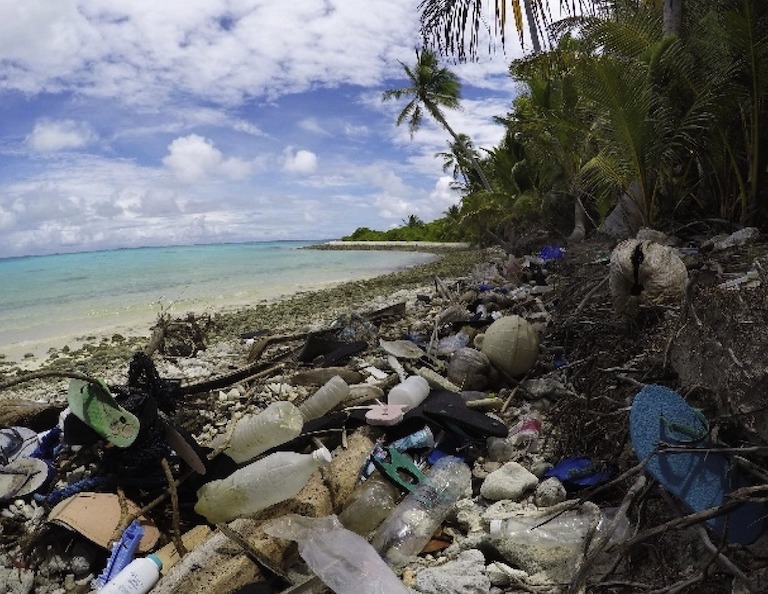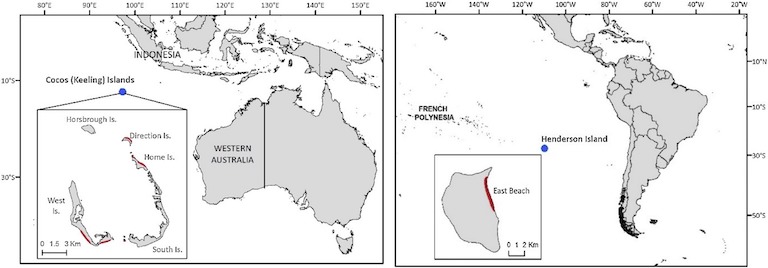- An estimated 570,000 hermit crabs become trapped and die in plastic containers on the remote Cocos (Keeling) Islands and Henderson Island each year, according to a new study.
- Accumulated plastics on beaches could cause a serious decline in hermit crab populations, the study’s authors say.
- Hermit crabs are at risk on beaches globally where crabs and plastic pollution overlap.
Remote islands are often held up as vestiges of pristine wilderness. In stark contrast, the Cocos (Keeling) Islands and Henderson Island are drowning in piles of plastic.
A recent study published in the Journal of Hazardous Materials estimates that more than half a million hermit crabs perish in accumulated plastic debris on the beaches of these heavily polluted remote islands alone each year.
The Cocos (Keeling) Islands, an Australian territory made up of 27 islands inhabited by about 600 people, sit 2,760 kilometers (1,715 miles) northwest of Perth in the Indian Ocean. A quarter-spin of the globe away, uninhabited Henderson Island, part of a British Overseas Territory, is located in the Pacific, halfway between New Zealand and Chile. The atoll, a UNESCO World Heritage Site, is positioned on the western perimeter of the South Pacific Gyre, a major source of the marine trash that coats its beaches.
“The significant quantities of debris on the beaches, and throughout the coastal vegetation, create a significant barrier which strawberry hermit crabs (Coenobita perlatus) encounter during their daily activities,” the paper says. “This is important for countless other islands worldwide where crabs and debris overlap, as crabs play a crucial role in the maintenance of tropical ecosystems.”

The marine plastic problem
Marine plastic pollution is a growing concern, with significant plastic accumulation on the high seas and plastic items documented at depths of nearly 11,000 meters (36,100 feet). According to the paper, plastics account for more than 95% of debris observed “at sea, on beaches and along river banks.”
Plastic debris can persist in the environment for decades, killing, maiming or sickening wildlife that become trapped or entangled or that mistake it for food. While marine plastic pollution is widely studied, until now little published research directly links it to species decline and wider environmental damage, or investigates the risk it poses on beaches and in nearby vegetation.
“These results are shocking but perhaps not surprising, because beaches and the vegetation that fringes them are frequented by a wide range of wildlife,” lead author Jennifer Lavers, a marine eco-toxicologist at the University of Tasmania’s Institute for Marine and Antarctic Studies, said in a news release about the study. “It is inevitable that these creatures will interact with and be affected by plastic pollution, although ours is one of the first studies to provide quantitative data on such impacts.”

The research team surveyed beaches on Henderson Island and the Cocos Islands in 2017 and 2019. Researchers counted plastic containers that could potentially cause entrapment because they had an opening and were positioned at an angle that would prevent crabs that entered from escaping, as well as both living and dead hermit crabs inside them. The researchers then used the survey data to predict total entrapment rates across the islands.
On Henderson Island there were approximately 38 million pieces of trash trapping and killing an estimated 61,000 crabs each year. On the Cocos Islands there were 414 million pieces of trash entrapping 508,000 crabs each year.
That worked out to 239 pieces of trash per square meter on the beaches of Henderson Island, and 713 on the Cocos Islands.
Hermit crabs are lured into plastic debris by the smell of decaying crabs in order to replace their own shells, an instinct that compounds the crabs’ demise. In one particularly lethal container on Henderson, the team found 526 trapped hermit crabs.



